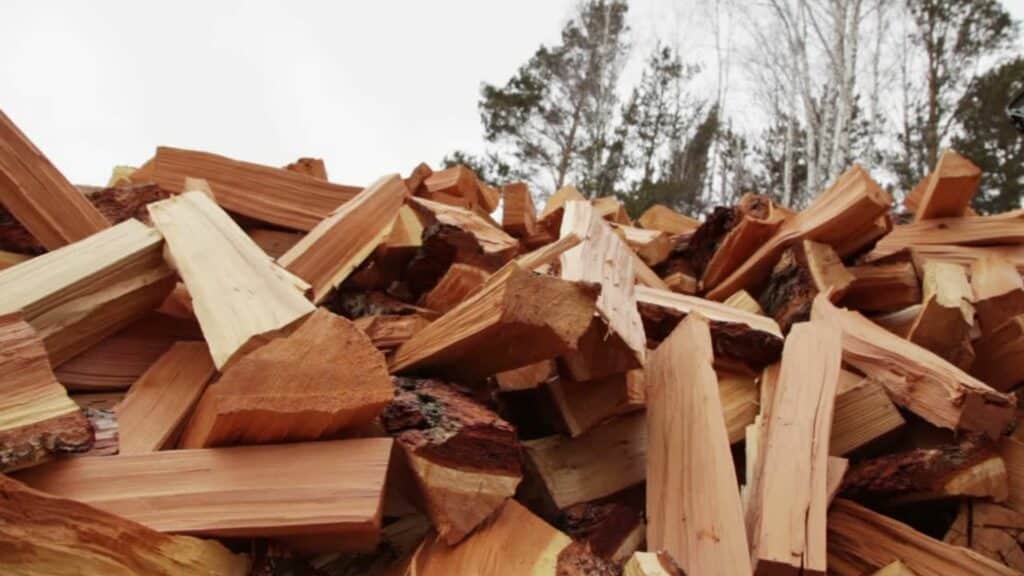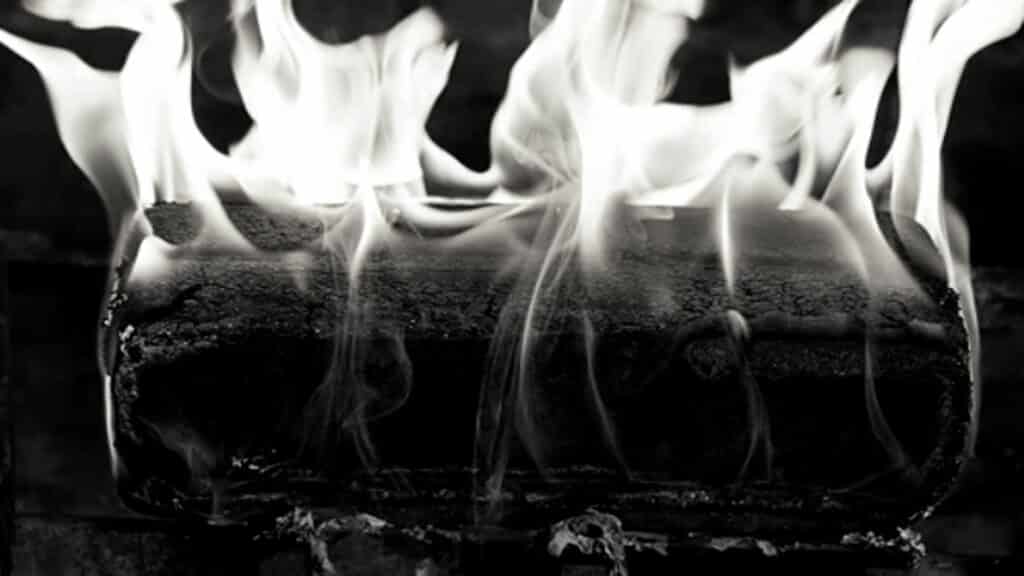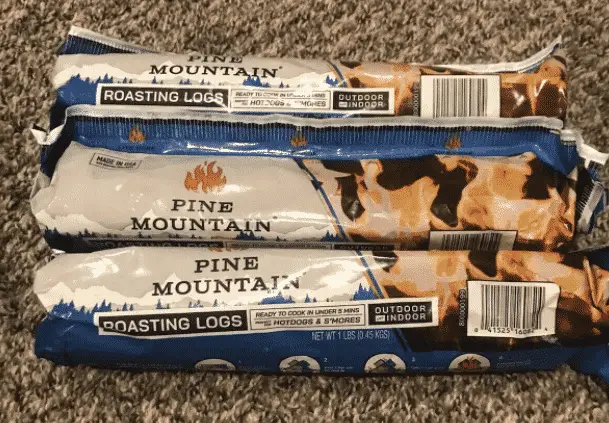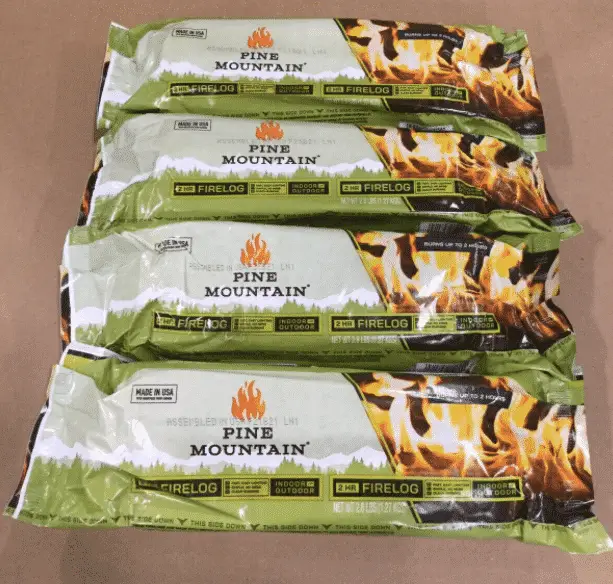As the weather gets chilly out, nothing sounds more satisfying than a war crackling fire. But if you’re anything like me, the demands of other tasks and household chores can get in the way of building a fire. That’s where fire starter logs come in. They make lighting and building a fire easy!
How do you use a fire starter log? You can either light a fire starter log to use on its own or they can help light a traditional wood log fire. Set the fire starter log in your fireplace or fire ring and light up the paper casing with a lighter. Building a starter log fire is that easy!
Table Of Contents
How To Light Fire Starter Logs
Building a fire with a firestarter log is surprisingly simple! They’re not a replacement for regular split wood logs, but they make building a fire simple. Fire Starter logs work as a slow burning tinder, kindling, fuel wood hybrid.
They can be used on their own or with additional kindling or regular firewood. The route you take will depend on the type of fire you want. Do you want an easy, compact, maintenance free fire? Or would you prefer using the fire starter logs to start a raging campfire using traditional kindling and firewood?
Fire logs are convenient to use on their own, but it’s not what most people picture when they think of a log fire. You set a single log in the fire, light it up to get 3-4 inch flames, and it burns for 2-4 hours depending on the log. That’s nice for ambiance, but it doesn’t put out much heat.
You’ll need to toss on regular firewood for a larger fire that puts out serious heat. Now that I got that out of the way, how do you start a fire using a fire starter logs?
Why Use Fire Starter Logs?
There are two main reasons why people use fire starter logs. They make building fires easy and you don’t have to store as much wood. You can build a 3 hour fire with a single starter log, instead of going through 10 regular logs in that same time frame. A small decorative firewood rack can hold enough starter logs to build fires for 2-3 weeks.
What do you need to build a fire with fire starter logs?
Fire Starter Logs- Throughout the years, I’ve tried almost every type of starter log on the market. They’re all basically the same with a few subtle differences. Premium logs burn 20-30 minutes longer and provide 10°-20°F more heat, but there’s not much of a difference.
Every starter log that I’ve used is made out of compressed sawdust, wood chips, cellulose, and heat regulating waxes. Some of the more expensive “Fancy” logs have crackling and popping effects, but that’s unnecessary if you’re using them alongside regular wood and kindling.
I recommend heading down to your local Walmart, Home Depot, Lowes, etc. and purchasing the cheapest fire logs you can find. I’d go with a 1.5 hour log or compact fire starters if you plan on using them with kindling or traditional wood.
Lighter, Match, Torch, etc.- This should be obvious, but you need matches or a lighter to start your fire. I use a flexible butane torch lighter (like this one) since it works upside down and allows you to bend the torch through the full sized logs.
Fire Pit, Fireplace, etc.- You need to have a safe place to build your fire. This can either be a portable fire ring, fireplace, wood burning stove, or a makeshift backcountry fire ring.
Can I Burn A Starter Log On Its Own? Kindling and Fuel Wood Is Optional

You can use starter logs on their own, but it’s not a direct replacement for a traditionally built fire. Fire starters light up like tinder, burn for hours, have 3-4 inch flames, and produce a decent amount of heat. That’s fine for a small fire in your fireplace, but most people prefer a larger fire using kindling and full sized firewood.
Ask yourself a simple question: is the fire for heat or ambiance? Starter logs give off a little bit of heat, but they burn slow with a small flame. Most people prefer using the starter log to build the fire and transitioning to full sized logs as the night progresses.
I recommend using the starter logs to start your fire, add a handful of kindling, and top it off with a log or two. You don’t technically need the kindling, but it will speed up the process transitioning over to solid fuel wood.
Kindling should be about the size of your thumb and larger fuel logs need to about 6 inches in diameter. Just make sure you give your fuel logs enough time to season before using them on your fire.
It takes at least 6 months for firewood to dry out after splitting and properly stacking it. Burning fresh cut “Green” wet wood will result in cold burning fire with lots of smoke. I get a heaping 7 ton trailer load of green firewood (just under 2 cords) delivered to my house for $150, but pre-seasoned wood will run $200-$300 per cord.
Building A Fire With Starter Logs

It shouldn’t take longer than 2 minutes to start a fire using starter logs. This shouldn’t need to be stated, but make sure you’re building a fire in a safe place. Make sure your chimney has been cleaned/inspected or the fire pit is located in a safe place. Now that I covered that boring public safety briefing, let’s go over building your fire with a starter log.
1) Clean Out Ash From Previous Fires
Sweep out any remaining ash from a previous fire into a metal container. Cover it up and store it outside on a concrete surface away from your house or other flammable surfaces.
2) Keep Flammable Items Away
Keep flammable items at least 3 feet away from your fireplace (carpet, curtains, rugs, etc.) or fire pit. I really wish I would have followed this step before getting a 3 inch burn hole in my living room carpet. Now I have a fire resistant fireplace hearth rug, so hopefully that won’t happen again.
3) Open The Flue
There should be a knob to open or close the flue located somewhere on your fireplace. You will either need to push/pull out the knob or rotate it to open your flue. You can tell if the flues open by looking at the smoke. If smoke billows and enters your home that means the flues either closed or clogged.
4) Don’t Remove The Outer Paper
Leave the outer paper packing on your fire log. The paper works as a makeshift tinder to make lighting up the log easier. Loosen the wrapper up a little bit, to improve airflow, without removing it from the log.
If you already removed the packaging tuck it under the log and light it up from the bottom up. Try to position the paper so it completely surrounds the outer edges of your fire log.
5) Position Your Fire Starter Log
Place your fire starter log in the center of your fireplace or firepit. Most fire starter logs are designed to be used one at a time, but there are logs that can be stacked in a cross pattern on top of each other. Using multiple logs won’t be cheap, but it will closer to a natural fire.
6) Light Up The Log
Take a lighter or matches and light up the loose paper on the corners of your fire log. I like to use a flexible butane torch (like this one) since it lets me reach wonky positions in the back of the log. Light each corner of the log on fire so the log burns evenly.
7) Add Additional Firewood (Optional)
At this point your fire starter log should be completely lit. You can either add additional firewood to build up the fire or leave the fire log to burn on its own. Check the fire logs package to see how long it should burn for. They usually go for 1.5 hours, 3 hours, or 4+ hours depending on the log size.
Make sure your firewood is properly seasoned. Burning green wood will result in a smoldering fire that produces lots of smoke. It takes at least 6 months for cut, split and properly stacked firewood to dry out until it’s properly seasoned.
You may want to check out my other posts: How long does it take to season firewood? and How can you tell if firewood is seasoned?
8) Close Your Mesh Screen and Leave Glass Doors Open
Once your fire is going, you need to close the mesh screen and leave the glass or metal doors open. This will allow heat to radiate into the room without ash and embers blowing into the room. You may be able to close the doors if your fireplace has a ventilation fan.
9) Wait 2-3 Days To Clean Up The Ash
Fire logs are highly efficient! So most of the log will burn without producing ash, but you will need to sweep out the fireplace eventually. Wait at least 2 days to clean out the ash to avoid sweeping up burning embers that could lead to burns or a fire.
Different Kinds Of Fire Starter Logs
I’ll try simplify this a bit, but there are 3 different kinds of fire starter logs to choose from. You have 4.5lb fire logs that can be used on their own for 3 hour fires, 2.5 lb logs for shorter 1.5 hour burns, and compact 3-6oz fire starters to start your fire before adding kindling and full-sized logs.
There are also different features and ingredients that can be found in each starter log. Some logs are “Environmentally Friendly”, designed to clean your fireplace, use different ingredients (charcoal, fatwood, etc.), added scents, and colored flames. Those added features are nice, but they’re completely unnecessary from a functional standpoint.
I recommend heading down to your local Walmart, Lowes, Home Depot, etc. and picking out the cheapest fire log you can find. It really doesn’t matter once you choose between a 3/1.5 hour burn or compact fire starter.
I usually go with a 6 pack of Pine Mountain 4 hour logs. I’ll then take one of the logs and cut them down into tiny chunks to use as fire starters for traditional kindling and firewood. The other 5 logs get used when I’m feeling lazy and don’t feel like building a conventional fire.
Don’t Cook Over Fire Starter Logs! Use Roasting Logs Instead

Roasting logs and fire starting logs look the same, but they serve a different purpose. You need to use a roasting log if you plan on cooking over the fire. I don’t think it’s dangerous to cook over a fire starting log (I’m not a doctor), but it will leave a nasty taste on your food.
Fire starting logs are coated in wax and vegetable oils which are safe to inhale, but they leave a fine residue on your food. Roasting logs are a little bit more expensive, but they’re designed for cooking. They’re made out of food grade cooking oils that will taste just like cooking over a wood burning fire.




